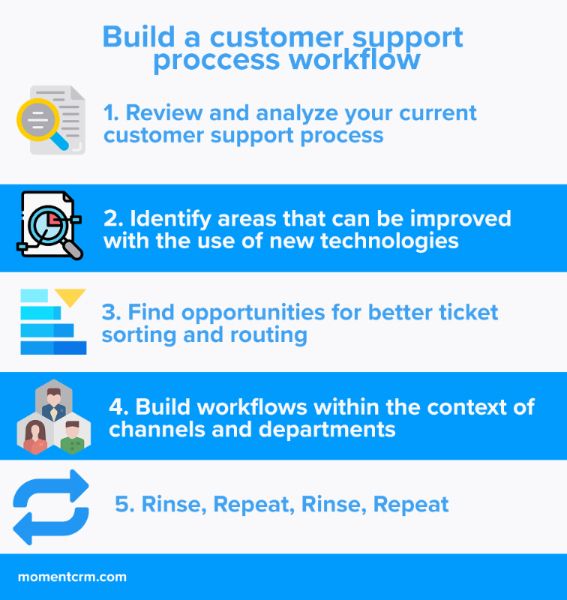How to Build a Customer Support Process Workflow: 5 Easy Steps

Customer Support is more complex than it seems.
And as we mentioned before, good customer support can translate into higher revenues for your business.
As a result, optimizing your customer support operations should be a key priority for your company. After all, you would not want to leave money on the table.
One way to achieve these optimizations is by using customer support process workflows.
The 5 steps to build a customer support process workflow:
- Review and analyze your current customer support processes
- Identify areas that can be improved with the use of new technologies
- Find opportunities for better ticket sorting and routing
- Build workflows within the context of channels and departments
- Rinse, Repeat, Rinse, Repeat
What is a workflow?
Workflows help businesses organize their processes in order to achieve certain tasks.
These are usually based on previous business experiences and specific business needs.
Think of it this way, workflows are visual representations of the step-by-step processes that help your business complete tasks more efficiently.
Why you need a customer support workflow

As we mentioned earlier, an optimized customer support workflow can have a significant impact on your business revenue. Here’s how:
Let’s take the example of a workflow for dealing with a support request regarding a billing issue.
This workflow would start with the customer contacting the business via any of their support channels and end with a support employee contacting the customer once their issue has been resolved.
But what matters is how you operationalize and chart the steps in between those ends.
In this scenario, you might want to ask yourself the following questions:
- Are you categorizing billing issues accordingly?
- Are billing issues of higher priority for your business?
- Does your support team have a specific sub-team that deals with support issues specifically?
How you decide to build a workflow for this support request can have an impact on both the quality of your support service and your bottom line.
How to create a customer support workflow
Now it’s time to create your own customer support workflow.
One thing to keep in mind is that the perfect workflow doesn’t exist. Take this as an ongoing optimization process, always having room for more improvement.
Your first workflow might not bring too many changes or improvements. But by applying multiple revisions over time, you will be able to significantly improve your support operations.
Without further ado, here are 5 steps to create your own customer support. We will break down each step.

1. Review and analyze your current customer support processes
It all starts with a review of your current processes. After all, you cannot improve something you don’t understand.
Take some time and plot out how your team currently deals with different support tasks.
- Which ones are the most time-consuming?
- Which ones happen the most often?
- Which ones involve more than one team member?
Take a data-driven approach to this and record specific data points into an excel spreadsheet. Or take a look at your current customer support KPIs, which you should be tracking.
2. Identify areas that can be improved with the use of new technologies
The easiest solutions to implement are often tech-related. Especially if you’re able to identify areas of your process flow that can be automated.
For example, is your customer support team manually asking for customer information when they reach out via live chat? Or is the tool automatically taking the customer through a flow of standard questions such as asking for their email address or customer ID?
How about auto-replies for common questions and issues? Or multi-channel implementations such as email fall back for live chat support?
Maybe your team is spending too much time trying to connect to your customers’ computers in order to see their screen and assist them. In this case, implementing browser recordings into your customer support flow would significantly improve your operations.
3. Find opportunities for better ticket sorting and routing
A common issue that adds time to ticket resolution times is improper ticket sorting and routing.
And we’re not just talking about sending billing tickets to the billing team. We’re talking about identifying who your “star reps” are and properly routing more high priority tickets to them.
If you’re tracking your KPIs to the rep level, this easy to identify and essentially let you create tiers of reps.
Additionally, this also motivates all support staff to improve their KPIs in order to make it up the tiers.
When looking at the individual performance of your reps, remember that every person is different. A rep that is not great at providing support via chat can be a star at phone support.
Are you structuring your team and routing tickets accordingly?
4. Build workflows within the context of channels and departments
Consider how your customer support workflow exists within the context of your company.
What we mean is that you need to consider that your workflow might not end within your department.
For example, let’s say your support team identifies a network-wide issue with your software that is affecting all customers and creating an outage in your services.
Does your support workflow include a component to notify the marketing team about this outage so it can be communicated to all customers? After all, this might not be the best moment to tweet about how good your software product is.
These considerations also need to exist within support teams, from billing support to technical support and further.
Remember, your customer support operations always exist within the context of your company.
5. Rinse, Repeat, Rinse, Repeat
This might be the most important step in the process. After all, there’s no perfect customer support workflow out there.
Make it part of your monthly or quarterly routine to review your current customer support flows and find further areas of improvement.
If you’re looking for new ideas to implement into your customer support flow, check our guide on our 10 customer support best practices to implement in 2020.
